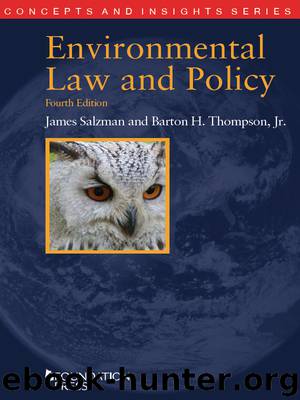Environmental Law and Policy, 4th (Concepts and Insights Series) by Thompson Jr. Barton & Salzman James

Author:Thompson Jr., Barton & Salzman, James [Inconnu(e)]
Language: eng
Format: epub
Publisher: West Academic
Published: 2013-11-26T01:00:00+00:00
Figure 6–2: CWA Technological Standards
4. Existing Point Sources
The CWA originally provided that effluent limitations for existing point sources should generally reflect the “best practicable control technology currently available” (“BPT”) by 1977 and the “best available technology economically achievable” (“BAT”) by 1983. Although the “best practicable control technology currently available” might sound more stringent than the “best available technology economically achievable,” Congress anticipated that BAT would be the more stringent of the two. In choosing BPT, EPA must balance the costs and benefits of alternative technologies. By contrast, EPA can “consider” cost in determining BAT, but is not supposed to directly compare the costs with the benefits. (If you find that difference a bit subtle, you are in good company.) In practice, BAT generally has been the environmentally best technology that is economically feasible. BAT does not require that the technology actually be in use, so long as it can be shown to work. In summary, the 1970 CWA anticipated that the technological standard for existing sources would become more stringent over time, with the cost of the technology playing less of a role.
In drafting the 1970 CWA, Congress also believed that a technological approach was not appropriate where a point source was discharging toxic pollutants. Here, Congress believed that the effluent limitations should be strict enough to protect human health, no matter how difficult or costly point sources would find it to meet the limitations.
Faced by industry objections, however, Congress backed away from applying the BAT standard on a universal basis to all existing
185
point sources and abandoned entirely its health-based approach to toxic pollutants. Under the CWA today, the technological standard that EPA uses to determine the effluent limitations for an existing point source depends on whether the pollution being released by the source is “toxic,” “conventional,” or “nonconventional.”
Toxic Pollutants. Toxic pollutants include a list of 126 chemical substances specified by Congress in the CWA, as well as any other pollutants that EPA determines to be toxic based on the pollutant’s toxicity, persistence, degradability, and impact on organisms. Because scientists only recently have begun to understand the health effect of many toxic pollutants in waterways, EPA found it virtually impossible to implement Congress’ original health-based approach. As a result, Congress abandoned the health-based approach and now requires EPA to use the BAT standard to calculate effluent limitations for these pollutants.
Conventional Pollutants. The CWA defines “conventional pollutants” as those pollutants that commonly pollute waterways, including biological oxygen demand (BOD), suspended solids, pH, fecal coliform, bacteria, oil, and grease. In place of the BAT standard, the CWA now requires EPA to use the “best conventional pollutant control technology” (BCT) to set effluent limitations for these pollutants. Although Congress anticipated that BCT would lie somewhere between BPT and BAT, EPA in most cases has treated BCT as very similar to the BPT standard.
Nonconventional Pollutants. Any pollutants that do not fit within the definitions of toxic or conventional pollutants, including ammonia, chloride, color, iron, and nitrate, are regulated as “nonconventional pollutants.” Such pollutants are
Download
This site does not store any files on its server. We only index and link to content provided by other sites. Please contact the content providers to delete copyright contents if any and email us, we'll remove relevant links or contents immediately.
What's Done in Darkness by Kayla Perrin(26593)
The Fifty Shades Trilogy & Grey by E L James(19079)
Shot Through the Heart: DI Grace Fisher 2 by Isabelle Grey(19058)
Shot Through the Heart by Mercy Celeste(18936)
Wolf & Parchment: New Theory Spice & Wolf, Vol. 10 by Isuna Hasekura and Jyuu Ayakura(17112)
Python GUI Applications using PyQt5 : The hands-on guide to build apps with Python by Verdugo Leire(16994)
Peren F. Statistics for Business and Economics...Essential Formulas 3ed 2025 by Unknown(16878)
Wolf & Parchment: New Theory Spice & Wolf, Vol. 03 by Isuna Hasekura and Jyuu Ayakura & Jyuu Ayakura(16825)
Wolf & Parchment: New Theory Spice & Wolf, Vol. 01 by Isuna Hasekura and Jyuu Ayakura & Jyuu Ayakura(16447)
The Subtle Art of Not Giving a F*ck by Mark Manson(14353)
The 3rd Cycle of the Betrayed Series Collection: Extremely Controversial Historical Thrillers (Betrayed Series Boxed set) by McCray Carolyn(14140)
Stepbrother Stories 2 - 21 Taboo Story Collection (Brother Sister Stepbrother Stepsister Taboo Pseudo Incest Family Virgin Creampie Pregnant Forced Pregnancy Breeding) by Roxi Harding(13645)
Scorched Earth by Nick Kyme(12771)
Drei Generationen auf dem Jakobsweg by Stein Pia(10965)
Suna by Ziefle Pia(10889)
Scythe by Neal Shusterman(10338)
The Ultimate Python Exercise Book: 700 Practical Exercises for Beginners with Quiz Questions by Copy(9529)
International Relations from the Global South; Worlds of Difference; First Edition by Arlene B. Tickner & Karen Smith(9522)
D:\Jan\FTP\HOL\Work\Alien Breed - Tower Assault CD32 Alien Breed II - The Horror Continues Manual 1.jpg by PDFCreator(9507)
